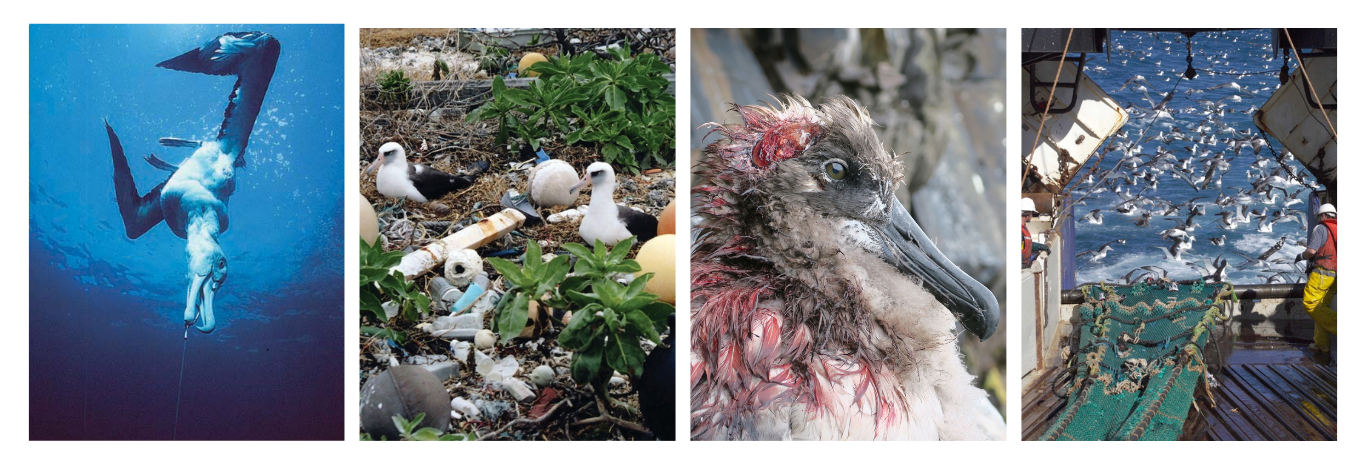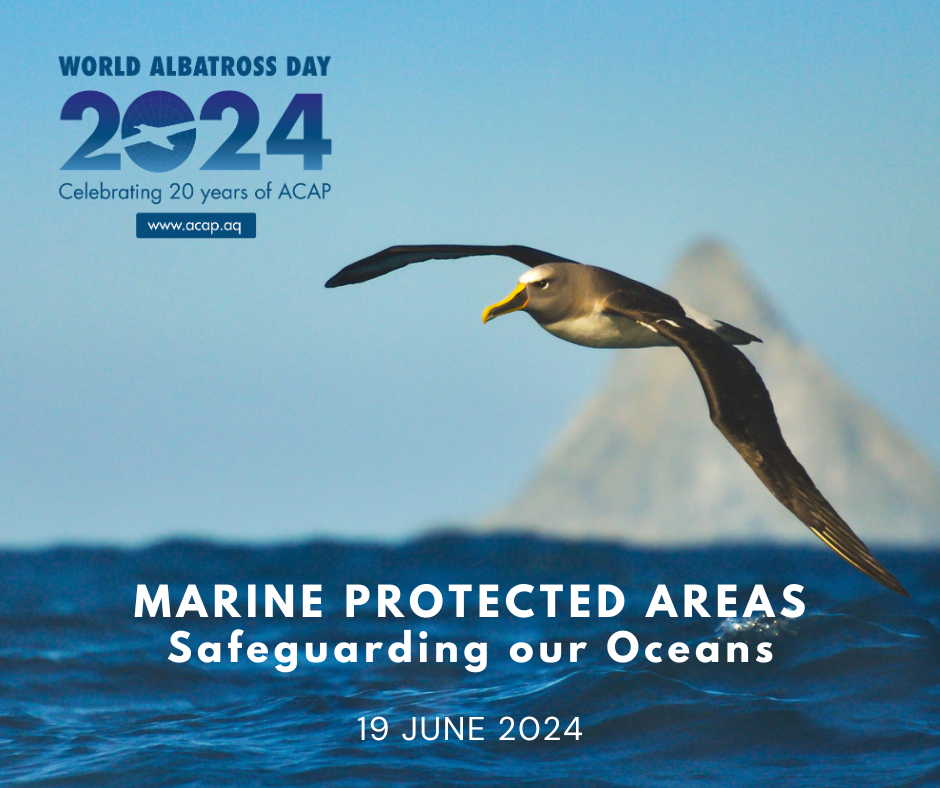 ACAP's commemorative logo to mark the Agreement's 20th anniversary was designed by South African Graphic Designer, Geoff Tyler.
ACAP's commemorative logo to mark the Agreement's 20th anniversary was designed by South African Graphic Designer, Geoff Tyler.
Today, 1 February 2024, the Agreement on the Conservation of Albatrosses and Petrels (ACAP) commemorates its 20th anniversary. Over the past two decades, ACAP Parties, researchers, non-Party Range States, Nongovernmental Organisations (NGOs) and other entities – a community of champions dedicated to the conservation of albatrosses and petrels - have shown a resolute commitment to seeking, promoting and implementing solutions to the crisis facing these magnificent birds.
The precarious state of albatross and petrel populations was first recognised in the 1990s when the scale of the incidental deaths of albatrosses and petrels in fisheries was realised by national governments, intergovernmental organisations and NGOs. Hundreds of thousands of birds were being incidentally injured or killed in fisheries operations (known as bycatch), through entanglements with fishing gear, or swallowing baited hooks and drowning. The conservation of these incredible birds became a focus, and the seeds of ACAP were sown.
The development of a regional agreement began under the Convention for Migratory Species (CMS) and remarkably, only two meetings were needed to finalise the Agreement. In 2001, the Agreement was opened for signature in Canberra, Australia, and it entered into force on 1 February 2004. Currently, ACAP has 13 Parties: Argentina, Australia, Brazil, Chile, Ecuador, France, New Zealand, Norway, Peru, South Africa, Spain, the United Kingdom, and Uruguay. 31 species of albatrosses and petrels (including shearwaters) are listed on Annex 1 of the Agreement.
 ACAP seeks to conserve listed albatrosses, petrels and shearwaters by coordinating international activity to mitigate known threats to their populations.Such threats include, fishing operations, pollution, predation from invasive species and habitat destruction. (Images left to right): A drowned Wandering Albatross caught on a tuna longline hook, photograph by Graham Robertson; Laysan Albatrosses amongst plastic debris, photograph by Steven Siegel, Marine Photobank; A bloodied Light-mantled Albatross after being attacked by invasive mice, photograph by Peter Ryan; Seabirds flock to a trawler vessel, photograph by Southern Seabird Solutions Trust
ACAP seeks to conserve listed albatrosses, petrels and shearwaters by coordinating international activity to mitigate known threats to their populations.Such threats include, fishing operations, pollution, predation from invasive species and habitat destruction. (Images left to right): A drowned Wandering Albatross caught on a tuna longline hook, photograph by Graham Robertson; Laysan Albatrosses amongst plastic debris, photograph by Steven Siegel, Marine Photobank; A bloodied Light-mantled Albatross after being attacked by invasive mice, photograph by Peter Ryan; Seabirds flock to a trawler vessel, photograph by Southern Seabird Solutions Trust
Albatrosses and petrels, with their extensive migratory ranges, confront a myriad of threats that transcend national boundaries. Fisheries, particularly longline and trawl operations, pose the greatest threat to ACAP’s 31-listed species. However, significant pressure on populations also stems from land-based predators such as mice, rats and cats. Other threats to populations include habitat loss, climate change, disease, and pollutants, including plastic and heavy metals.
ACAP functions as a focus for international cooperation to mitigate these threats, The Action Plan annexed to the Agreement provides a framework for the development of effective conservation measures, both on land and at sea, and fosters the exchange of information and expertise. Key initiatives include reducing seabird bycatch through the review and recommendation of seabird bycatch mitigation measures, engaging with fisheries organisations, conducting population assessments, and developing conservation guidelines. ACAP also champions research and capacity-building initiatives through its small grants and secondment programmes, fostering collaboration among Parties. More recently, the establishment of World Albatross Day, celebrated annually on 19 June, has provided a focus to increase public awareness of these incredible birds and their imperilled state.
 A Buller’s Albatross flies past New Zealand’s Pyramid Rock. Celebrating 20 years of ACAP will form a part of this year’s World Albatross Day on 19 June. Photograph by Enzo M.R. Reyes
A Buller’s Albatross flies past New Zealand’s Pyramid Rock. Celebrating 20 years of ACAP will form a part of this year’s World Albatross Day on 19 June. Photograph by Enzo M.R. Reyes
This year, ACAP will mark the fifth World Albatross Day on 19 June with the theme “Marine Protected Areas – Safeguarding our Oceans”. ACAP’s newly designed logo for “WAD2024” takes note of the anniversary year, which will also be marked with a poster, two new infographics in the ACAP Species series and ACAP’s fifth collaboration with Artists and Biologists United for Nature (ABUN).
Despite the achievements and dedication of the community of champions committed to the conservation of ACAP species, many albatross and petrel populations continue to decline. Challenges persist, such as the need for accurate data on seabird bycatch locations and quantities and the imperative to involve Range States and other entities in implementing ACAP's recommendations.
The commitment to achieving and maintaining a favourable conservation status for albatrosses and petrels remains the Agreement’s driving force. It emphasises the importance of a cooperative approach to overcome challenges. As ACAP enters its third decade, the focus remains on ensuring that these majestic seabirds continue to grace our oceans and skies well into the future.
Reference:
Cooper, J., Baker, G.B., Double, M.C., Gales, R., Papworth, W, Tasker, M.L. & Waugh, S.M. 2006. The Agreement on the Conservation of Albatrosses and Petrels: rationale, history, progress and the way forward. Marine Ornithology 34: 1-5.
ACAP Secretariat
1 February 2024

 English
English  Français
Français  Español
Español